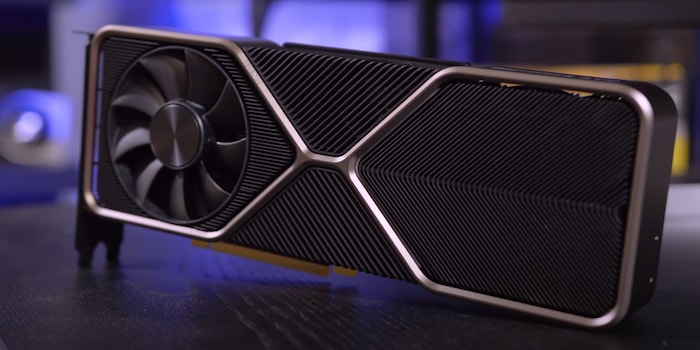
GeForce RTX 3080: What the Founders Edition can do
The GeForce RTX 3080, the first consumer graphics card with Ampere architecture, will be launched on 17 September. Manufacturer Nvidia has advertised up to twice the performance of its predecessor in advance. Initial benchmarks partially confirm these claims.
The promised doubling of performance has triggered real hype for the new GeForce cards. The article announcing the cards has been commented on over 500 times here at digitec. That's how we usually only handle apple news. Now the first independent benchmarks of the RTX 3080 show what the card is actually capable of.
The Ampere architecture
The RTX 30 series is manufactured by Samsung using the 8 nm process. The chips have a transistor density of 44.6MT/mm2 (GA102) compared to 24.7 MT/mm2 for Turing (TU102). The largest Ampere RTX GPU - the GA102 - has 28 billion transistors and a die size of 628.4 mm2. This chip is used for the GeForce RTX 3090 and the RTX 3080.
The Nvidia GeForce RTX 30 series offers second-generation RT cores designed to further improve the acceleration of ray tracing. The third-generation Tensor cores are intended to further increase performance in the upscaling of DLSS (Deep Learning Supersampling).
Another change to the Founders Edition of the RTX-30 series is the new 12-PIN connector, which can deliver up to 300 W of power. The cooling system in push-pull configuration is also new. There is also support for HDMI 2.1.
Here are the detailed specs of the GeForce RTX 3080 compared to the RTX 2080 Super, which I tested myself:
| Specs | GeForce RTX 3090 | GeForce RTX 3080 | GeForce RTX 2080 Super | GeForce RTX 2080 Ti |
|---|---|---|---|---|
| CUDA cores | 10496 | 8704 | 3072 | 4352 |
| Tensor cores | 328 (3rd generation) | 272 (3rd generation) | 384 (2nd generation) | 544 (2nd generation) |
| RT cores | 82 (2nd generation) | 68 (2nd generation) | 48 (1st generation) | 68 (1st generation) |
| Boost clock | 1.7 GHz | 1.71 GHz | 1.8 GHz | 1.54 GHz |
| Base clock | 1.4 GHz | 1.44 GHz | 1.6 GHz | 1.35 GHz |
| Memory | 24 GB G6X | 10 GB G6X | 8 GB DDR6 | 11 GB DDR6 |
| Memory Clock | 19.5 Gbps | 19 Gbps | 15.5 Gbps | 16 Gbps |
| Memory interface | 384 bit | 320 bit | 256 bit | 352 bit |
| Memory bandwidth | 936 GB/s | 760 GB/s | 448 GB/s | 616 GB/s |
| TGP | 350 watts | 320 watts | 250 watts | 250 watts |
The benchmarks
Wccftech writes that the RTX 3080 leaves the RTX 2080 Ti, the previous gaming queen, in the dust. The RTX 2080 Ti costs almost twice as much. The review particularly emphasises the cooling performance of the RTX 3080 Founders Edition. The card remains cool despite the TDP of 320 watts.
Golem is a little more critical of the cooling performance: the push-pull configuration of the cooler causes the CPU temperature to rise. In addition, a power supply unit would have to be at least 100 watts more powerful than a GeForce RTX 2080, even though the RTX 3080 is significantly more efficient. In terms of rasterisation performance in 4K, the German portal writes that the RTX 3080 is on average 70 per cent faster than a GeForce RTX 2080 - in some cases even twice as fast. This difference is even more extreme with ray tracing.
TomsHardware emphasises the relatively low price of the RTX 3080. For 500 dollars less than an RTX 2080 Ti, there is a card that performs 30 per cent better. In TomsHardware's test titles, the RTX 3080 does not perform quite as well as Golem, but it still delivers 66 per cent more performance at 4K than the RTX 2080. However, the card is more suitable for 4K gaming than in 1440p resolution. According to the US site, you should keep your hands off the card at 1080p. If 4K is not your goal, you should wait for the RTX 3070.
TechPowerUp blows a similar horn. With the exception of one test title, the card achieves more than 60 FPS in 4K. GPU overclocking is very limited. Memory overclocking, on the other hand, works surprisingly well. A ten per cent increase in memory is possible, with four per cent more performance overall.
And for us?
The availability of the cards is currently still being clarified. Our colleague Yannick Cejka will let you know as soon as we know more.
As we here at digitec do not sell the Founders Edition, the reviews of which were published today, we have unfortunately not received a test sample from Nvidia. However, I have an RTX 3080 from Asus in my hands. Since Nvidia has unfortunately not yet provided me with any drivers for testing after several requests, I will have to wait until tomorrow at 15:00 to review the RTX 3080. That's when the Founders Edition cards go on sale and the official drivers for the RTX 3080 are available. I'm putting in a night shift so that I can provide you with the first results of the Asus partner card on Friday.
From big data to big brother, Cyborgs to Sci-Fi. All aspects of technology and society fascinate me.
From the latest iPhone to the return of 80s fashion. The editorial team will help you make sense of it all.
Show all